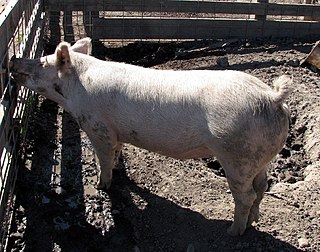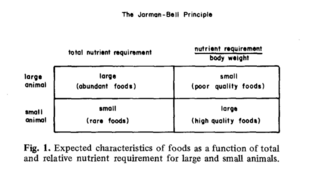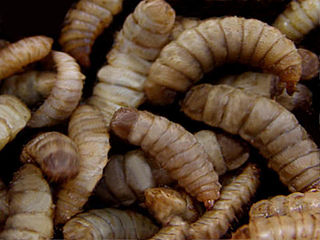Related Research Articles

The Belgian Blue is a breed of beef cattle from Belgium. It may also be known as the Race de la Moyenne et Haute Belgique, or dikbil. Alternative names for this breed include Belgian Blue-White; Belgian White and Blue Pied; Belgian White Blue; Blue; and Blue Belgian. The Belgian Blue's extremely lean, hyper-sculpted, ultra-muscular physique is termed "double-muscling". The double-muscling phenotype is a heritable condition resulting in an increased number of muscle fibres (hyperplasia), instead of the (normal) enlargement of individual muscle fibres (hypertrophy).

Meat is animal tissue, often muscle, that is eaten as food. Humans have hunted and farmed other animals for meat since prehistoric times. The Neolithic Revolution allowed the domestication of animals including chickens, sheep, goats, pigs, horses, and cattle, starting around 11,000 years ago. Since then, selective breeding has enabled farmers to produce meat with the qualities desired by producers and consumers.

Animal husbandry is the branch of agriculture concerned with animals that are raised for meat, fibre, milk, or other products. It includes day-to-day care, management, production, nutrition, selective breeding, and the raising of livestock. Husbandry has a long history, starting with the Neolithic Revolution when animals were first domesticated, from around 13,000 BC onwards, predating farming of the first crops. By the time of early civilisations such as ancient Egypt, cattle, sheep, goats, and pigs were being raised on farms.

There are different systems of feeding cattle in animal husbandry. For pastured animals, grass is usually the forage that composes the majority of their diet. In turn, this grass-fed approach is known for producing meat with distinct flavor profiles. Cattle reared in feedlots are fed hay supplemented with grain, soy and other ingredients to increase the energy density of the feed. The debate is whether cattle should be raised on fodder primarily composed of grass or a concentrate. The issue is complicated by the political interests and confusion between labels such as "free range", "organic", or "natural". Cattle raised on a primarily foraged diet are termed grass-fed or pasture-raised; for example meat or milk may be called grass-fed beef or pasture-raised dairy. The term "pasture-raised" can lead to confusion with the term "free range", which does not describe exactly what the animals eat.
The rumen, also known as a paunch, is the largest stomach compartment in ruminants and the larger part of the reticulorumen, which is the first chamber in the alimentary canal of ruminant animals. The rumen's microbial favoring environment allows it to serve as the primary site for microbial fermentation of ingested feed. The smaller part of the reticulorumen is the reticulum, which is fully continuous with the rumen, but differs from it with regard to the texture of its lining.

Fish meal, sometimes spelt fishmeal, is a commercial product made from whole wild-caught fish, bycatch, and fish by-products to feed farm animals, e.g., pigs, poultry, and farmed fish. Because it is calorically dense and cheap to produce, fishmeal has played a critical role in the growth of factory farms and the number of farm animals it is possible to breed and feed.
High-quality feed block or HQFB, is a solid block consisting of molasses, non-protein nitrogen (NPN), rumen by-pass protein, minerals and lipids. It is provided to livestock ruminants in a manner similar to a salt lick.

Beef cattle are cattle raised for meat production. The meat of mature or almost mature cattle is mostly known as beef. In beef production there are three main stages: cow-calf operations, backgrounding, and feedlot operations. The production cycle of the animals starts at cow-calf operations; this operation is designed specifically to breed cows for their offspring. From here the calves are backgrounded for a feedlot. Animals grown specifically for the feedlot are known as feeder cattle, the goal of these animals is fattening. Animals not grown for a feedlot are typically female and are commonly known as replacement heifers. While the principal use of beef cattle is meat production, other uses include leather, and beef by-products used in candy, shampoo, cosmetics, and insulin.

Proteins are essential nutrients for the human body. They are one of the building blocks of body tissue and can also serve as a fuel source. As a fuel, proteins provide as much energy density as carbohydrates: 4 kcal per gram; in contrast, lipids provide 9 kcal per gram. The most important aspect and defining characteristic of protein from a nutritional standpoint is its amino acid composition.
The dry matter or dry weight is a measure of the mass of a completely dried substance.

Soybean meal is used in food and animal feeds, principally as a protein supplement, but also as a source of metabolizable energy. Typically 1 bushel of soybeans yields 48 lbs. (21.8 kg) of soybean meal. Soybean meal is produced as a co-product of soybean oil extraction. Some, but not all, soybean meal contains ground soybean hulls. Soybean meal is heat-treated during production, to denature the trypsin inhibitors of soybeans, which would otherwise interfere with protein digestion.

The environmental impacts of animal agriculture vary because of the wide variety of agricultural practices employed around the world. Despite this, all agricultural practices have been found to have a variety of effects on the environment to some extent. Animal agriculture, in particular meat production, can cause pollution, greenhouse gas emissions, biodiversity loss, disease, and significant consumption of land, food, and water. Meat is obtained through a variety of methods, including organic farming, free-range farming, intensive livestock production, and subsistence agriculture. The livestock sector also includes wool, egg and dairy production, the livestock used for tillage, and fish farming.

Meat and bone meal (MBM) is a product of the rendering industry. It is typically about 48–52% protein, 33–35% ash, 8–12% fat, and 4–7% water. It is primarily used in the formulation of animal feed to improve the amino acid profile of the feed. Feeding of MBM to cattle is thought to have been responsible for the spread of BSE ; therefore, in most parts of the world, MBM is no longer allowed in feed for ruminant animals. However, it is still used to feed monogastric animals.

Manufactured feeds are an important part of modern commercial aquaculture, providing the balanced nutrition needed by farmed fish. The feeds, in the form of granules or pellets, provide the nutrition in a stable and concentrated form, enabling the fish to feed efficiently and grow to their full potential.

The Australian Yorkshire is a breed of domestic pig from Australia that was originally a part of the Yorkshire breed of pigs from Yorkshire, England. It is said to be the most common and popular breed of pig in Australia due to economic and nutritional advantages.

Farmageddon: The True Cost of Cheap Meat is a 2014 non-fiction book by Philip Lymbery and Isabel Oakeshott. It surveys the effects of industrial livestock production and industrial fish farming around the world. The book is the result of Lymbery's investigations for which he travelled the world over three years. Isabel Oakeshott is the political editor of The Sunday Times, Lymbery is CEO of Compassion in World Farming. The book was published by Bloomsbury.

Feed manufacturing refers to the process of producing animal feed from raw agricultural products. Fodder produced by manufacturing is formulated to meet specific animal nutrition requirements for different species of animals at different life stages. According to the American Feed Industry Association (AFIA), there are four basic steps:
- Receive raw ingredients: Feed mills receive raw ingredients from suppliers. Upon arrival, the ingredients are weighed, tested and analyzed for various nutrients and to ensure their quality and safety.
- Create a formula: Nutritionists work side by side with scientists to formulate nutritionally sound and balanced diets for livestock, poultry, aquaculture and pets. This is a complex process, as every species has different nutritional requirements.
- Mix ingredients: Once the formula is determined, the mill mixes the ingredients to create a finished product.
- Package and label: Manufacturers determine the best way to ship the product. If it is prepared for retail, it will be "bagged and tagged," or placed into a bag with a label that includes the product's purpose, ingredients and instructions. If the product is prepared for commercial use, it will be shipped in bulk.

FutureFeed was established by Australia's Commonwealth Scientific and Industrial Research Organisation (CSIRO), FutureFeed holds the global intellectual property for the use of Asparagopsis seaweed as a ruminant livestock feed ingredient that can reduce methane emissions by 80% or more. This result can be achieved by the addition of a small amount of the seaweed into the daily diet of livestock. This discovery was made by a team of scientists from CSIRO and James Cook University (JCU), supported by Meat & Livestock Australia (MLA), who came together in 2013 to investigate the methane reduction potential of various native Australian seaweeds.

The Jarman–Bell principle is a concept in ecology that the food quality of a herbivore's intake decreases as the size of the herbivore increases, but the amount of such food increases to counteract the low quality foods. It operates by observing the allometric properties of herbivores. The principle was coined by P.J Jarman (1968.) and R.H.V Bell (1971).

Insects as feed are insect species used as animal feed, either for livestock, including aquaculture, or as pet food.
References
- 1 2 Dan Shike, University of Illinois Beef Cattle Feed Efficiency
- 1 2 DJ Cottle and WS Pitchford. Production Efficiency. Chapter 18 in Beef Cattle Production and Trade, Ed Lewis Kahn. Csiro Publishing, 2014 ISBN 9780643109896 Pp 439-440
- ↑ Stickney, Robert R. (2009) Aquaculture: An Introductory Text, page 248, CABI, ISBN 9781845935894.
- ↑ Arthur P.F. et al. 2014 Lessons Learnt from 25 Years of Feed Efficiency Research in Australia. Proceedings, 10th World Congress of Genetics Applied to Livestock Production. Abstract here
- 1 2 3 4 Mike Varley for Pig Progress. Taking control of feed conversion ratio Apr 1, 2009, Last update:Jan 26, 2011
- ↑ National Research Council (Subcommittee on Environmental Stress). 1981. Effect of environment on nutrient requirements of domestic animals. National Academy Press, Washington. 168 pp.
- ↑ Dennis DiPietre for Pig 333. April 21, 2014 Feed Conversion Ratio: critically important but often misused
- 1 2 3 4 5 Dan W. Shike, Ph.D., University of Illinois at Urbana-Champaign Driftless Region Beef Conference 2013 Beef Cattle Feed Efficiency
- ↑ Travis D. Maddock, Darren D. Henry, and G. Cliff Lamb. Animal Sciences Department, UF/IFAS Extension. AN217: The Economic Impact of Feed Efficiency in Beef Cattle Original publication date May 2009. Revised October 2015.
- 1 2 Robert C. Fry, Atlantic Dairy Management Services. Measuring Feed Efficiency Why & How on the Back of a Napkin
- 1 2 3 Virginia Ishler for Progressive Dairyman. June 30, 2014 Calculating feed efficiency
- ↑ Cornell University, University of Wisconsin-Madison, USDA-Agricultural Research Service, Dairy Forage Research Center April 30, 2004 Whole-Farm Nutrient Management on Dairy Farms to Improve Profitability and Reduce Environmental Impacts
- 1 2 Michael F. Hutjens August 21, 2012 Feed Efficiency and Its Impact on Feed Intake
- ↑ USDA Natural Resources Conservation Service Conservation Practice Standard: Feed Management: (Animal Units (AUs) Affected): Code 592. September 2011
- 1 2 Tony Hall for Eastern Dairy Business September 2011 Define And Improve Your Herd’s Feed Conversion Ratio
- 1 2 Jukes TH (February 1992). "Today's non-Orwellian animal farm". Nature. 355 (6361): 582. doi: 10.1038/355582a0 . PMID 1538742. S2CID 4308400.
- ↑ Department of Agriculture and Fisheries, Queensland Government. Managing a piggery >> Production and performance >> Performance standards Last updated 28 September 2012
- ↑ David R. Stender, Iowa State University Extension. IPIC 25h. Swine Feed Efficiency: Influence of Market Weight 2012
- ↑ Knott, S. A., B. J. Leury, L. J. Cummins, F. D. Brien and F. R. Dunshea. 2003. Relationship between body composition, net feed intake and gross feed conversion efficiency in composite sire line sheep. In: Souffrant, W. B. and C. C. Metges (eds.). Progress in research on energy and protein metabolism. EAAP publ. no. 109. Wageningen
- ↑ Brand, T. S., S. W. P. Cloete and F. Franck. 1991. Wheat-straw as roughage component in finishing diets of growing lambs. S. Afr. J. Anim. Sci 21: 184-188.
- 1 2 National Research Council. 2007. Nutrient requirements of small ruminants. National Academies Press. 362 pp.
- ↑ Fahmy, M. H., J. M. Boucher, L. M. Pose, R. Grégoire, G. Butler and J. E. Comeau. 1992. Feed efficiency, carcass characteristics, and sensory quality of lambs, with or without prolific ancestry, fed diets with different protein supplements. J. Anim. Sci. 70: 1365-1374
- ↑ Malik, R. C., M. A. Razzaque, S. Abbas, N. Al-Khozam and S. Sahni. 1996. Feedlot growth and efficiency of three-way cross lambs as affected by genotype, age and diet. Proc. Aust. Soc. Anim. Prod. 21: 251-254.
- ↑ Cronjé. P. B. and E. Weites. 1990. Live mass, carcass and wool growth responses to supplementation of a roughage diet with sources of protein and energy in South African Mutton Merino lambs. S. Afr. J. Anim. Sci. 20: 141-168
- 1 2 3 4 Peter Best for WATTagnet.com November 24, 2011 Poultry performance improves over past decades
- 1 2 MacLeod, M.; Gerber, P.; Mottet, A.; Tempio, G.; Falcucci, A.; Opio, C.; Vellinga, T.; Henderson, B.; Steinfeld, H. (2013). Greenhouse gas emissions from pig and chicken supply chains – a global life cycle assessment (PDF). Food and Agriculture Organization of the United Nations. ISBN 978-92-5-107944-7.
- ↑ Mississippi State University Extension Service Broiler Breeder Management Is No Easy Task, 2013
- ↑ "FIFO explanation document" (PDF). Archived from the original (PDF) on 2016-10-10. Retrieved 2016-06-04.
- ↑ "FIFO explained". Archived from the original on 2016-07-01. Retrieved 2016-06-04.
- ↑ "Fish in: Fish Out (FIFO) ratios for the conversion of wild feed to farmed fish, including salmon | IFFO - The Marine Ingredients Organisation". IFFO. 2010-04-16. Retrieved 2020-04-04.
- ↑ FAO Cultured Aquatic Species Information Programme: Salmo salar (Linnaeus, 1758) 2004
- ↑ Dennis P. DeLong, Thomas M. Losordo and James E. Rakocy Southern Regional Aquaculture Center SRAC Publication No. 282: Tank Culture of Tilapia June 2009
- ↑ USAID Harvest. "Technical Bulletin #07: Feed Conversion Ratio (FCR): How to calculate it and how it is used" (PDF). Retrieved 22 March 2024.
- 1 2 3 4 5 Alexander, Peter; Brown, Calum; Arneth, Almut; Dias, Clare; Finnigan, John; Moran, Dominic; Rounsevell, Mark D.A. (December 2017). "Could consumption of insects, cultured meat or imitation meat reduce global agricultural land use?". Global Food Security. 15: 22–32. doi: 10.1016/j.gfs.2017.04.001 . hdl: 20.500.11820/17f627e0-ff81-4492-87d8-97bd6f454840 .
- ↑ Tamilnadu Veterinary Animal Sciences University Extension Service. TNAU Animal Husbandry ::Rabbit No date on website; site accessed June 16, 2016
- 1 2 3 4 5 6 Mottet, A.; de Haan, C.; Falcucci, A.; Tempio, G.; Opio, C.; Gerber, P. (2022). More fuel for the food/feed debate. Rome: FAO.
- 1 2 3 4 5 6 Mottet, Anne; de Haan, Cees; Falcucci, Alessandra; Tempio, Giuseppe; Opio, Carolyn; Gerber, Pierre (2017-09-01). "Livestock: On our plates or eating at our table? A new analysis of the feed/food debate". Global Food Security. Food Security Governance in Latin America. 14: 1–8. doi:10.1016/j.gfs.2017.01.001. ISSN 2211-9124.
- ↑ In Huis, Arnold. (2012). Potential of Insects as Food and Feed in Assuring Food Security. Annual review of entomology. 58. 10.1146/annurev-ento-120811-153704

